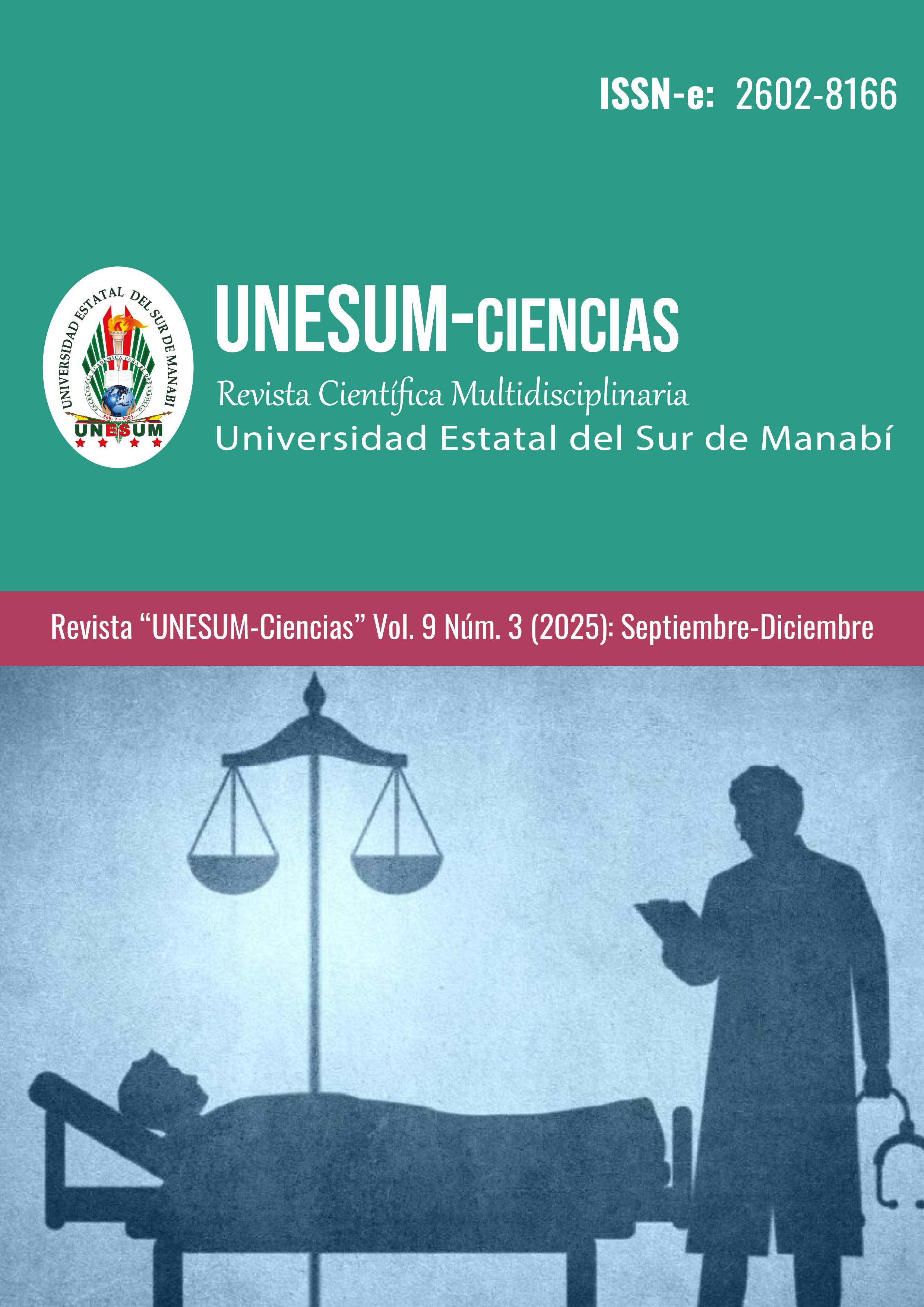Uso de insumos agrícolas y factores ambientales sobre la productividad de cultivos permanentes: Un análisis basado en la ESPAC 2023
DOI:
https://doi.org/10.47230/unesum-ciencias.v9.n3.2025.123-139Palavras-chave:
Semilla, Fertilizantes, Fitosanitarios, Regresión por pasos, Productividad, MulticolinealidadResumo
Los cultivos permanentes representan una estrategia clave para la sostenibilidad agrícola en Ecuador, al ofrecer rendimientos estables sin requerir replantación anual. No obstante, existen pocos estudios que analicen de forma integral los factores que determinan su productividad. Este estudio analiza el efecto de los insumos agrícolas y de los factores ambientales sobre la productividad de cultivos permanentes en Ecuador, utilizando modelos de regresión lineal por pasos a partir de los datos de la Encuesta de Superficie y Producción Agropecuaria Continua (ESPAC 2023). Se analizaron variables como tipo de semilla, uso de fertilizantes y fitosanitarios, riego y eventos climáticos adversos. La colinealidad elevada en fertilizantes (VIF = 89), fitosanitarios (VIF = 76) y riego (VIF = 46.9) motivó su exclusión del modelo, mientras que variables como plagas y enfermedades (VIF ? 1) se mantuvieron. Los resultados indican que el uso de semilla común tuvo un efecto positivo significativo sobre la productividad, mientras que el uso de herbicidas mostró un efecto negativo. El modelo explicó el 99.8% de la variabilidad de la productividad (R² ajustado = 0.998). Se concluye que el rendimiento agrícola depende de un manejo adecuado de semillas y agroquímicos. Se recomienda fortalecer la capacitación técnica y promover prácticas sostenibles para mejorar la rentabilidad y resiliencia de los cultivos permanentes en el país.
Downloads
Referências
Arias, J., & Araya, M. (2021). Perspectivas de la Agricultura y del Desarrollo Rural en las Américas: una mirada hacia América Latina y el Caribe 2021-2022. San José: Comisión Económica para América Latina y el Caribe (CEPAL). https://repositorio.cepal.org/server/api/core/bitstreams/ec3e9a9f-593e-4c55-85a3-b5eefbeca839/content
Arias, N., & Rios, J. (2025). Estudio comparativo de productos químicos y biológicos para el control de enfermedades del cultivo de soya (Glycine max (L) Merrill), en el norte del Valle del Cauca, Colombia. Universidad Nacional Abierta y a Distancia. https://repository.unad.edu.co/handle/10596/67803
Bellon Hernandez, O. (2016). Diseño y simulación de un controlador en tiempo discreto para regulación de temperatura en un invernadero a escala. Prospect, 14(1), 80-88. http://ojs.uac.edu.co/index.php/prospectiva/article/view/646/455
Burgos, N., Singh, V., Tseng, T., Black, H., & al, e. (2014). The Impact of Herbicide-Resistant Rice Technology on Phenotypic Diversity and Population Structure of United States Weedy Rice. Plant Physiol, 166(3), 1208-1220. https://doi.org/ 10.1104/pp.114.242719
Camacho, W., Barros, J., Crespo, N., & Mejía, J. (2020). Medición de la productividad en la actividad agrícola. JOURNAL OF SCIENCE AND RESEARCH, 5(2020), 80-90. https://doi.org/10.5281/zenodo.4725768
Del Angel-Pérez, A., Villagómez-Cortés, J., Larqué-Saavedra, B., Adame-García, J., & al, e. (2018). Preferencias y percepciones asociadas con semilla mejorada de maíz según productores de Veracruz Central, México. Revista Mexicana de Ciencias Agrícolas, 9(1), 167-173. https://doi.org/10.29312/remexca.v9i1.856
Díaz-Chuquizuta, P., Hidalgo-Melendez, E., Cabrejo-Sánchez, C., & Valdés-Rodríguez, O. (2022). Respuesta del maíz (Zea mays L.) a la aplicación foliar de abonos orgánicos líquidos. Chilean Journal of Agricultural & Animal Science, 38(2), 144-153. https://doi.org/10.29393/CHJAA38-14RMPO40014
Diez, R., Gómez, R., & Linares, A. (2018). Rentabilidad de la innovación genética en maíz amarillo duro (Zea mays L. var indurata) y papa blanca (Solanum tuberosum) en el Perú. Enfoque, 2(3), 43-74. https://doi.org/https://doi.org/10.26439/enfoque2016.n002.1870
FAO. (2020). El estado mundial de la pesca y la acuicultura (SOFIA). FAO. https://doi.org/10.4060/ca9229es
García-Salazar, J., & Ramírez-Jaspeado, R. (2014). EL MERCADO DE LA SEMILLA MEJORADA DE MAÍZ (Zea mays L.) EN MÉXICO. UN ANÁLISIS DEL SALDO COMERCIAL POR ENTIDAD FEDERATIVA. Revista Fitotecnia Mexicana, 37(1), 69-77. https://doi.org/10.35196/rfm.2014.1.69
González-Fragoso, H., Zabaleta-Solano, C., Devia-González, J., Moya-Salinas, Y., & al, e. (2020). Efecto del riego con agua residual tratada sobre la calidad microbiológica del suelo y pasto King Grass. Revista U.D.C.A Actualidad & Divulgación Científica, 23(2), 1-9. https://doi.org/10.31910/rudca.v23.n2.2020.1513
He, Y., Jaiswal, D., Liang, X., & al, e. (2022). Perennial biomass crops on marginal land improve both regional climate and agricultural productivity. GCB Bioenergy, 14(5), 558-571. https://doi.org/10.1111/gcbb.12937
Hidalgo, B. (2013). Los Impactos del Cambio Climático en el Sector Agropecuario Hondureño. Perspectivas del Desarrollo, 2(2), 144-161. https://www.camjol.info/index.php/RPDD/article/view/1318
INEC. (2024). Encuesta de Superficie y Producción Agropecuaria Continua. ESPAC. https://www.ecuadorencifras.gob.ec/documentos/web-inec/Estadisticas_agropecuarias/espac/2023/Principales_resultados_ESPAC_2023.pdf
Jiao, X., Lyu, Y., Wu, X., Li, H., & al, e. (2016). Grain production versus resource and environmental costs: towards increasing sustainability of nutrient use in China. Journal of Experimental Botany, 67(17), 4935-4949. https://doi.org/10.1093/jxb/erw282
Khan, M. (2023). Economic feasibility of different cropping systems in Newfoundland and Labrador. Memorial University of Newfoundland. http://research.library.mun.ca/id/eprint/16337
Lambert, T., Santiesteban, R., Ceiro, W., Fernández, M., & al, e. (2019). Effect of bioproducts in the production of Phaseolus vulgaris L. and Arachis hipogea L. Revistas de Ciencias Agrícolas, 36(1), 59-66. https://doi.org/10.22267/rcia.193601.98
Lowenberg-DeBoer, J., Preckell, P., & Fontanilla, C. (s.f.). Feasibility Study for Development of Cashew-Based Farming Operations in Vichada. Colombia Purdue Partnership, 1-15. https://www.purdue.edu/colombia/partnerships/orinoquia/docs/Vichada%20Study_CPP_CS18-3_Sep242018.pdf
Montero, R. (2016). Modelos de regresión lineal múltiple. Documentos de Trabajo en Economía Aplicada. Universidad de Granada. https://www.ugr.es/~montero/matematicas/regresion_lineal.pdf
Olivares, B., Hernández, R., Arias, A., Molina, J., & al, e. (2018). Zonificación agroclimática del cultivo de maíz para la sostenibilidad de la producción agrícola en Carabobo, Venezuela. Revista Universitaria de Geografía, 27(2), 135-157. https://www.scielo.org.ar/scielo.php?script=sci_arttext&pid=S1852-42652018000200006
Patiño, J., Cotes, J., & Ramírez, J. (2014). Efecto de Pyraclostrobin en la Producción de Papa Cultivar Diacol Capiro. Editorial Neogranadina, 10(1), 8-21. https://doi.org/10.18359/rfcb.333
Pérez-Leira, R., & Domínguez-Gutiérrez, J. (2019). Irrigation Regime for Crops in Manabí, Ecuador: Proposal for Five Permanent Crops. Revista Ciencias Técnicas Agropecuarias, 28(4), 63-72. http://scielo.sld.cu/pdf/rcta/v28n4/es_2071-0054-rcta-28-04-e06.pdf
Pinzón Moreno, I., & Fuentes Rojas, E. (2022). Factibilidad del uso de técnicas y procesos de la agricultura orgánica para el manejo y mantenimiento fitosanitario del cultivo de limón común en la finca Cerco de Piedra en el municipio de Villa vieja Huila. Ingeniería Y Región, 28(2022), 17-34. https://doi.org/10.25054/22161325.3591
Tamayo, C., & Alegre, J. (2022). Asociación de cultivos, alternativa para el desarrollo de una agricultura sustentable. Siembra, 9(1), 1-21. https://doi.org/10.29166/siembra.v9i1.3287
Zhang, y., Li, Y., Jiang, L., Tian, C., & al, e. (2011). Potential of Perennial Crop on Environmental Sustainability of Agriculture. Procedia Environmental Sciences, 10(2011), 1141-1147. https://doi.org/10.1016/j.proenv.2011.09.182
Downloads
Publicado
Como Citar
Edição
Seção
Licença
Copyright (c) 2025 Diana Julissa Valverde Jalca, Gabriela Elizabeth Revelo Salgado

Este trabalho está licenciado sob uma licença Creative Commons Attribution 4.0 International License.




